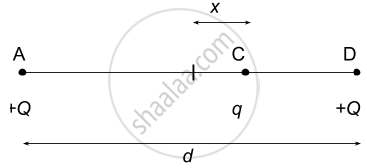Advertisements
Advertisements
प्रश्न
Repeat the previous problem if the particle C is displaced through a distance x along the line AB.
उत्तर
 Net force
Net force
\[= \frac{1}{4\pi \in_0}\left[ \frac{Qq}{\left( \frac{d}{2} - x \right)^2} - \frac{Qq}{\left( \frac{d}{2} + x \right)^2} \right]\]
\[ = \frac{Qq}{4\pi \in_0}\frac{\left[ \left( \frac{d}{2} \right)^2 + x^2 + xd - \left( \frac{d}{2} \right)^2 - x^2 + xd \right]}{\left[ \left( \frac{d}{2} \right)^2 - x^2 \right]^2}\]
when,
x << d
So, net force = \[\frac{qQ}{4\pi \in_0}\frac{\left( 2xd \right)}{d^4}\]
\[ = \frac{qQ}{4\pi \in_0}\frac{2x}{d^3}\]
\[\text{ Or m }\left( \frac{2\pi}{T} \right)^2 x = \frac{2xqQ}{4\pi \in_0 d^3}\]
\[T = \left[ \frac{\pi^3 \in_0 m d^3}{2Qq} \right]^{1/2}\]
APPEARS IN
संबंधित प्रश्न
Two equal balls with equal positive charge 'q' coulombs are suspended by two insulating strings of equal length. What would be the effect on the force when a plastic sheet is inserted between the two?
Four charges +q, −q, +q and −q are to be arranged respectively at the four corners of a square ABCD of side 'a'.
(a) Find the work required to put together this arrangement.
(b) A charge q0 is brought to the centre of the square, the four charges being held fixed. How much extra work is needed to do this ?
Plot a graph showing the variation of coulomb force (F) versus ,`(1/r^2)` where r is the distance between the two charges of each pair of charges: (1 μC, 2 μC) and (2 μC, − 3 μC). Interpret the graphs obtained.
Does the force on a charge due to another charge depend on the charges present nearby?
Find the dimensional formula of ε0.
Suppose an attractive nuclear force acts between two protons which may be written as F=Ce−kr/r2. Write down the dimensional formulae and appropriate SI units of C and k.
A hydrogen atom contains one proton and one electron. It may be assumed that the electron revolves in a circle of radius 0.53 angstrom (1 angstrom = 10−10 m and is abbreviated as Å ) with the proton at the centre. The hydrogen atom is said to be in the ground state in this case. Find the magnitude of the electric force between the proton and the electron of a hydrogen atom in its ground state.
Two small spheres, each with a mass of 20 g, are suspended from a common point by two insulating strings of length 40 cm each. The spheres are identically charged and the separation between the balls at equilibrium is found to be 4 cm. Find the charge on each sphere.
Two particles A and B, each carrying a charge Q, are held fixed with a separation dbetween them. A particle C of mass m and charge q is kept at the middle point of the line AB. Assuming x<<d, show that this force is proportional to x.
Solve numerical example.
Three equal charges of 10×10-8 C respectively, each located at the corners of a right triangle whose sides are 15 cm, 20 cm, and 25cm respectively. Find the force exerted on the charge located at the 90° angle.
Explain in detail Coulomb’s law and its various aspects.
Two positive charges ______.
A charge Q is divided into two parts of q and Q – q. If the coulomb repulsion between them when they are separated is to be maximum, the ratio of Q/q should be ______.
Coulomb's law is given by F = k q1q2 rn where n is
Two charge – 10c and + 10 c are placed 10 cm apart. Potential at centre of the line joining the two charge is:-
The capacity of an isolate conducting sphere of radius R is proportional to
Identify the wrong statement in the following.
Coulomb's law correctly describes the electric force that ______
According to Coulomb's law, which is the correct relation for the following figure?

